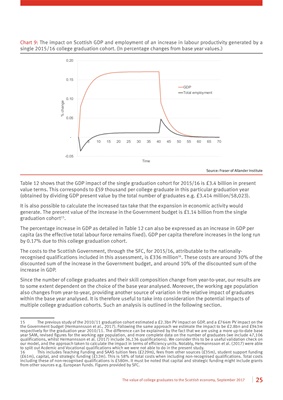
25
The value of college graduates to the Scottish economy, September 2017
Chart 9: The impact on Scottish GDP and employment of an increase in labour productivity generated by a
single 2015/16 college graduation cohort. (In percentage changes from base year values.)
-0.05
-
0.05
0.10
0.15
0.20
5 10 15 20 25 30 35 40 45 50 55 60 65 70
% change
Time
GDP
Total employment
Source: Fraser of Allander Institute
Table 12 shows that the GDP impact of the single graduation cohort for 2015/16 is £3.4 billion in present
value terms. This corresponds to £59 thousand per college graduate in this particular graduation year
(obtained by dividing GDP present value by the total number of graduates e.g. £3.414 million/58,023).
It is also possible to calculate the increased tax take that the expansion in economic activity would
generate. The present value of the increase in the Government budget is £1.14 billion from the single
graduation cohort15.
The percentage increase in GDP as detailed in Table 12 can also be expressed as an increase in GDP per
capita (as the effective total labour force remains fixed). GDP per capita therefore increases in the long run
by 0.17% due to this college graduation cohort.
The costs to the Scottish Government, through the SFC, for 2015/16, attributable to the nationallyrecognised
qualifications included in this assessment, is £336 million16. These costs are around 30% of the
discounted sum of the increase in the Government budget, and around 10% of the discounted sum of the
increase in GDP.
Since the number of college graduates and their skill composition change from year-to-year, our results are
to some extent dependent on the choice of the base year analysed. Moreover, the working age population
also changes from year-to-year, providing another source of variation in the relative impact of graduates
within the base year analysed. It is therefore useful to take into consideration the potential impacts of
multiple college graduation cohorts. Such an analysis is outlined in the following section.
15 The previous study of the 2010/11 graduation cohort estimated a £2.3bn PV impact on GDP, and a £764m PV impact on the
the Government budget (Hermannsson et al., 2017). Following the same approach we estimate the impact to be £2.8bn and £943m
respectively for the graduation year 2010/11. The difference can be explained by the fact that we are using a more up-to-date base
year SAM, revised figures for the working age population, and more complete data on the number of graduates (we include 47,106
qualifications, whilst Hermannsson et al. (2017) include 36,136 qualifications). We consider this to be a useful validation check on
our model, and the approach taken to calculate the impact in terms of efficiency units. Notably, Hermannsson et al. (2017) were able
to split out Acdemic and Vocational qualifications which we were not able to do in the present study.
16 This includes Teaching Funding and SAAS tuition fees (£229m), fees from other sources (£35m), student support funding
(£61m), capital, and strategic funding (£12m). This is 58% of total costs when including non-recognised qualifications. Total costs
including these of non-recognised qualifications is £580m. It must be noted that capital and strategic funding might include grants
from other sources e.g. European Funds. Figures provided by SFC.